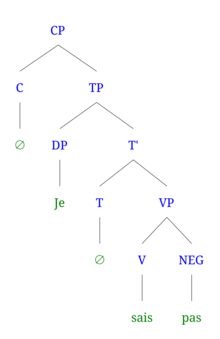English grammar is the set of structural rules of the English language. This includes the structure of words, phrases, clauses, sentences, and whole texts.
An auxiliary verb is a verb that adds functional or grammatical meaning to the clause in which it occurs, so as to express tense, aspect, modality, voice, emphasis, etc. Auxiliary verbs usually accompany an infinitive verb or a participle, which respectively provide the main semantic content of the clause. An example is the verb have in the sentence I have finished my lunch. Here, the auxiliary have helps to express the perfect aspect along with the participle, finished. Some sentences contain a chain of two or more auxiliary verbs. Auxiliary verbs are also called helping verbs, helper verbs, or (verbal) auxiliaries. Research has been conducted into split inflection in auxiliary verbs. There are 24 auxiliary verbs in English: 11 primary and 13 modal.

A double negative is a construction occurring when two forms of grammatical negation are used in the same sentence. This is typically used to convey a different shade of meaning from a strictly positive sentence. Multiple negation is the more general term referring to the occurrence of more than one negative in a clause. In some languages, double negatives cancel one another and produce an affirmative; in other languages, doubled negatives intensify the negation. Languages where multiple negatives affirm each other are said to have negative concord or emphatic negation. Portuguese, Persian, French, Russian, Polish, Bulgarian, Greek, Spanish, Old English, Italian, Afrikaans, and Hebrew are examples of negative-concord languages. This is also true of many vernacular dialects of modern English. Chinese, Latin, German, Dutch, Japanese, Swedish and modern Standard English are examples of languages that do not have negative concord. Typologically, negative concord occurs in a minority of languages.
The imperative mood is a grammatical mood that forms a command or request.
A tag question is a construction in which an interrogative element is added to a declarative or an imperative clause. The resulting speech act comprises an assertion paired with a request for confirmation. For instance, the English tag question "You're John, aren't you?" consists of the declarative clause "You're John" and the interrogative tag "aren't you?"

Englishauxiliary verbs are a small set of English verbs, which include the English modal auxiliary verbs and a few others. Although the auxiliary verbs of English are widely believed to lack inherent semantic meaning and instead to modify the meaning of the verbs they accompany, they are nowadays classed by linguists as auxiliary on the basis not of semantic but of grammatical properties: among these, that they invert with their subjects in interrogative main clauses and are negated either by the simple addition of not or by negative inflection.

The English modal auxiliary verbs are a subset of the English auxiliary verbs used mostly to express modality (properties such as possibility and obligation). They can most easily be distinguished from other verbs by their defectiveness (they do not have participles or plain forms) and by their lack of the ending ‑(e)s for the third-person singular.
An interrogative clause is a clause whose form is typically associated with question-like meanings. For instance, the English sentence "Is Hannah sick?" has interrogative syntax which distinguishes it from its declarative counterpart "Hannah is sick". Also, the additional question mark closing the statement assures that the reader is informed of the interrogative mood. Interrogative clauses may sometimes be embedded within a phrase, for example: "Paul knows who is sick", where the interrogative clause "who is sick" serves as complement of the embedding verb "know".
In linguistics, a polarity item is a lexical item that is associated with affirmation or negation. An affirmation is a positive polarity item, abbreviated PPI or AFF. A negation is a negative polarity item, abbreviated NPI or NEG.
Taba is a Malayo-Polynesian language of the South Halmahera–West New Guinea group. It is spoken mostly on the islands of Makian, Kayoa and southern Halmahera in North Maluku province of Indonesia by about 20,000 people.
An existential clause is a clause that refers to the existence or presence of something, such as "There is a God" and "There are boys in the yard". The use of such clauses can be considered analogous to existential quantification in predicate logic, which is often expressed with the phrase "There exist(s)...".
Araki is a nearly extinct language spoken in the small island of Araki, south of Espiritu Santo Island in Vanuatu. Araki is gradually being replaced by Tangoa, a language from a neighbouring island.

Dagaare is the language of the Dagaaba people of Ghana, Burkina Faso, and Ivory Coast. It has been described as a dialect continuum that also includes Waale and Birifor. Dagaare language varies in dialect stemming from other family languages including: Dagbane, Waale, Mabia, Gurene, Mampruli, Kusaal, Buli, Niger-Congo, and many other sub languages resulting in around 1.3 million Dagaare speakers. Throughout the regions of native Dagaare speakers the dialect comes from Northern, Central, Western, and Southern areas referring to the language differently. Burkina Faso refers to Dagaare as Dagara and Birifor to natives in the Republic of Côte d'Ivoire. The native tongue is still universally known as Dagaare. Amongst the different dialects, the standard for Dagaare is derived from the Central region's dialect. Southern Dagaare also stems from the Dagaare language and is known to be commonly spoken in Wa and Kaleo.
The syntax of the Welsh language has much in common with the syntax of other Insular Celtic languages. It is, for example, heavily right-branching, and the verb for be is crucial to constructing many different types of clauses. Any verb may be inflected for three tenses, and a range of additional tenses are constructed with auxiliary verbs and particles. Welsh lacks true subordinating conjunctions, and instead relies on special verb forms and preverbal particles to create subordinate clauses.
Yes and no, or similar word pairs, are expressions of the affirmative and the negative, respectively, in several languages, including English. Some languages make a distinction between answers to affirmative versus negative questions and may have three-form or four-form systems. English originally used a four-form system up to and including Early Middle English and Modern English has reduced to a two-form system consisting of yes and no. It exists in many facets of communication, such as: eye blink communication, head movements, Morse code, and sign language. Some languages, such as Latin, do not have yes-no word systems.

Do-support, in English grammar, is the use of the auxiliary verb do, including its inflected forms does and did, to form negated clauses and questions as well as other constructions in which subject–auxiliary inversion is required.
Tense–aspect–mood or tense–modality–aspect is a group of grammatical categories that are important to understanding spoken or written content, and which are marked in different ways by different languages.
In linguistics, negative inversion is one of many types of subject–auxiliary inversion in English. A negation or a word that implies negation or a phrase containing one of these words precedes the finite auxiliary verb necessitating that the subject and finite verb undergo inversion. Negative inversion is a phenomenon of English syntax. Other Germanic languages have a more general V2 word order, which allows inversion to occur much more often than in English, so they may not acknowledge negative inversion as a specific phenomenon. While negative inversion is a common occurrence in English, a solid understanding of just what elicits the inversion has not yet been established. It is, namely, not entirely clear why certain fronted expressions containing a negation elicit negative inversion, but others do not.
In linguistics, negative raising is a phenomenon that concerns the raising of negation from the embedded or subordinate clause of certain predicates to the matrix or main clause. The higher copy of the negation, in the matrix clause, is pronounced; but the semantic meaning is interpreted as though it were present in the embedded clause.
In linguistics, a minimizer is a word or phrase that denotes a very small quantity which is used to reinforce negation. For example, red cent is a minimizer in the sentence "I'm not paying him a red cent".









